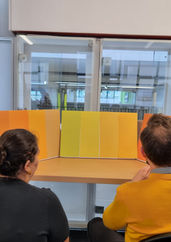UX of Yellow
2 Week Group Project
Varsha, Bea, Farah, Yixi, Kyle, May
Brief: Design an Experience Based on the Characteristics of the Colour Yellow.
Create an experience based on the characteristics of yellow using the colour yellow. What are the characteristics of yellow? I began my research with this question, utilising research methods such as a creative tool kit and artefact analysis.


The Research
Visiting the Tranquility and JOY exhibition at the Wellcome Collection for more inspiration and concept ideas. The exhibition JOY shares a variety of uplifting experiences in catharsis and resilience including communities and friendship. The installations by Harold Offeh caught my attention as his work explores moments of societal trauma where communities sought spaces for redemptive and joyful release by dancing. We were also inspired by Aiden Mosby's periodic table of emotions, which attempts to broaden how we speak about our feelings. His work covers an emotional spectrum.
First Idea
Inspired by the Joy exhibition's periodic table representations of different colours, our first thought was to find different shades of yellow with known meanings. The artist's colour "Sunflower Yellow," for example, depicts a sunflower.
We used the Behavioral Design method with volunteers during this concept and asked them to draw what each shade of yellow meant to them. We were trying to figure out how the colour yellow influences people's perceptions of different shades of yellow. We wanted to alter people's perceptions of meaning and representation without revealing which shades of yellow were used.

Second Idea

Our second idea was developed from watching a video clip of children explaining art to adults and trying to explain colours to a person who is blind. In the video the blind person gave the children a question ‘When you think of colours what do you think of?’ they responded ‘How do I explain this?’ The children then started using sounds, movements and descriptions, for instance explaining that the colour blue reminded them of water. This inspired us to look at characteristics such as sound/touch/movements of Yellow.
Without viewing the colour yellow we wanted to find out what type of sound makes yellow and what yellow feels like. For instance, we could use hand warmers as a warm touch representation of yellow or sand. The sound might be laughter, cheers of joy, or maracas, combining these representations.
From this idea, we expanded our investigation into an experiment with objects that we could find which created movement and sound, as well as texture representations. Using these objects we created a tool kit and a secure space for volunteers to express the colour yellow through textures, sound and movement.
How do we perceive the colour yellow through movement and sound?

After brainstorming and visualizing our concepts we decided to design an immersive experience for our volunteers to become conscious and aware of the way they could interact with different shades of yellow.
We visualised using curtains draped down from the ceiling to create that immersive space filled with shades of yellow.
We designed an installation structure and a specific code that picks up only sound using P5 code. The darker the yellow, the quieter the sound, and the brighter the yellow, the louder the sound. In addition, we wanted to test a different version p5 code to track movements using a webcam.
Although testing both sound and movement codes was successful, it was discovered when using both projectors for both code overlapped the different shades of yellow creating the outcome to be messy. We decided as a group to use sound as our primary interactive device, but movement would still be linked to our piece due to the noise produced by movements. This enabled our volunteers to make noise with various movements, allowing both projectors to intensify the yellow shades to one code.


How did we measure success?
While facilitating, I asked each volunteer to demonstrate various ways to make sounds.
We measured success by capturing the sound of our volunteers' interactions with the installation through movements as they sang, danced, and made noise with body movements.
Overall, the installation was a success based on the positive feedback about how much fun it was to interact creatively with it.













